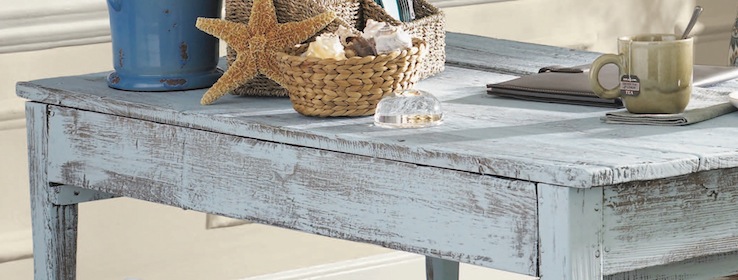How to Distress Furniture
Supplies Needed:
Furniture to be distressed
Sherwin-Williams latex primer such as Multi-Purpose Latex Primer
Sherwin-Williams latex paint in two shades (dark for the base coat, light for the topcoat)
Paint sticks
Paint trays
Purdy 2½-inch or 3-inch angled paint brushes (depending on the furniture size)
Paste wax
Rag for applying wax
Sandpaper (120-grit, 100-grit and 80-grit)
Tack cloth
Drop cloth or plastic
Sherwin-Williams Wood Classics Polyurethane Varnish
Step 1: Lightly sand the furniture in the direction of the wood grain. After sanding is complete, wipe the furniture with tack cloth to remove all dust.
• Sanding Tip: If the furniture is already painted or varnished, sand all surfaces well to remove the coating(s) completely. Start by sanding with coarse, 80-grit sandpaper. Then, move to less coarse sandpaper such as 100- or 120-grit to smooth the surface.
Step 2: Using a 2½-inch or 3-inch brush, prime the entire piece with the Sherwin-Williams latex primer you've selected and apply in the direction of the wood grain. Let dry for 24 hours.
• Priming Tip: Thoroughly mix the primer with a paint stick and pour a small amount into a paint tray. Dip an angled brush into the primer, covering no more than ½ inch to 1 inch of the brush. Use the side of the tray to wipe excess primer off the brush, helping to avoid drips while priming.
Step 3: Apply the darker, base coat of paint with a 2½-inch or 3-inch brush (use a larger brush for a larger piece of furniture). Let dry for 24 hours.
• Painting Tip: Thoroughly mix the paint with a paint stick and pour a small amount into a clean paint tray. Dip an angled brush into the paint, covering no more than ½ inch to 1 inch of the brush. Use the side of the tray to wipe excess paint off the brush, helping to avoid drips while painting.
Step 4: Using a clean rag, apply a thin, even coat of paste wax on the areas you want to appear distressed. Ideal areas include corners, edges and around knobs. Allow wax to dry for one hour.
Step 5: Apply the lighter, topcoat of paint in the direction of the wood grain using a 2½-inch or 3-inch brush. Cover the wax and bottom coat of paint completely. Let dry for 24 hours.
Step 6: Lightly sand waxed areas of the furniture, in the direction of the wood grain, using 80-,100- and 120-grit sandpaper. Alternate between sandpapers to create variations in the distressed look. This process removes the topcoat of paint, allowing the darker base coat to show through.
Step 7: Once you’ve reached your desired look, wipe the furniture down with tack cloth to remove all sanding dust. Remaining wax does not need to be removed — it will dry and harden over time.
Step 8: Apply one coat of Sherwin-Williams Wood Classics Polyurethane Varnish to the entire surface using a 2½-inch to 3-inch brush. Allow the furniture to dry overnight.
Disclaimer: While this specific technique requires wax to achieve a distressed look, it is not recommended to use paint over waxed surfaces. Before beginning a project, test the technique on a small, hidden part of the furniture to ensure desirable results.





